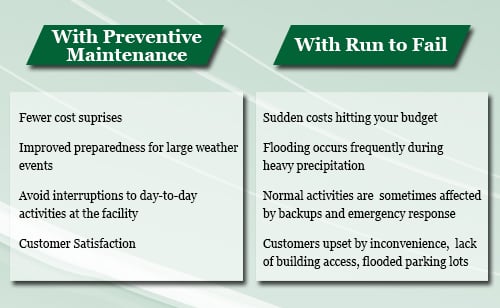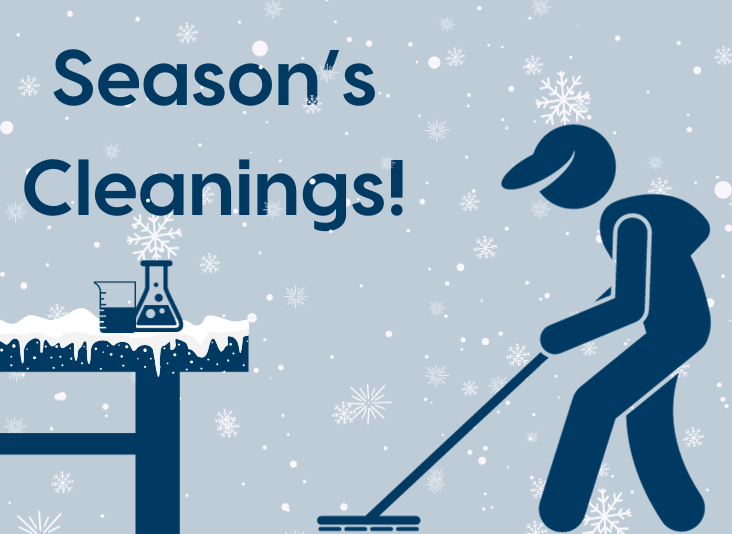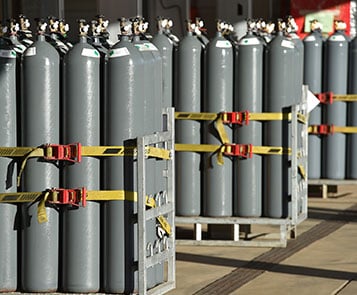How Often Should You Clean Your Catch Basins?
Among the multitude of equipment a facilities staff must oversee, catch basins (or storm drains) are certainly not the most complex; however, they play a vital role in maintaining the safety and health of a facility. A catch basin accepts stormwater, provides some basic physical filtration, and then releases the effluent into the watershed or a sewer system.
So as long as stormwater continues to drain, what is there to worry about?
Probably not much — but at some point, the catch basin will back up, and a contractor will be brought in to fix the problem until the next flooding occurs. For many facilities, such a “run-to-fail” policy may be working just fine.
But is it the most economically efficient approach to managing catch basins?
To answer for yourself, consider some of the differences between these two options:
- Conduct biannual inspections and perform cleanings as needed.
- Fix problems as they arise.
Consider Option 1: When performing preventive maintenance on catch basins, companies can employ a clamshell truck to remove about 80% of accumulated solids—enough to ensure the integrity of the catch basin. Clamshells provide the fastest, most efficient cleaning option, which means the labor and equipment cost per catch basin is smaller. Overall, the total costs for option 1 include an inspection fee plus the clamshell, operator, and disposal on any cleanings that do occur.
Consider Option 2: When employing a solely reactive approach, the costs depend on the frequency of flooding and the extent of the maintenance required when flooding occurs. At a minimum, the work would require a vacuum truck (instead of a clamshell) to pump out the liquids and solids. Here, the costs include the equipment, a two-person operating team, and disposal of any pumped out materials. If materials build up in the outflow pipe itself, the job would also require confined space entry and manual scrubbing of the catch basin with an industrial cleaning solution. While this may be the worst case scenario, the extra labor costs can add up quickly.
In addition to the direct invoice costs, a thorough cost-benefit analysis will account for the indirect factors as well. Taking a deeper dive into the total cost of preventative maintenance vs run-to-fail will reveal the following:

In reality, there is no magic formula to determine the “optimal” amount of preventive maintenance for catch basins. Variables such as climate, local topography, and design capacity mean that different catch basins will require different amounts of maintenance. Facility functions and user preferences may also be significant factors.
It is important, however, to note that preventative maintenance programs will help mitigate risks and prevent costly emergencies that arise from backed up catch basins and flooding.
When to Inspect
Get started with catch basin maintenance by performing visual inspections twice a year. Depending on where you're located, there are specific times of the year that are optimal for equipment inspection. For example, in the northern states:
- In autumn, after the leaves have fallen; and
- In spring, after snow melt and road treatment by salt and sand.
In southern states, where snow is not an issue, it is still wise to inspect catch basins at least twice a year. Inspecting before and after hurricane season can help prevent back up and mitigate flooding in times of heavy precipitation.
Keep a log that tracks how quickly materials accumulate in each catch basin. If there’s one that is always flooding, it may need quarterly cleanings. On the other hand, if one catch basin remains empty after multiple inspections, it can probably be left alone in the future.

There may be real opportunities in catch basin maintenance to save costs and add value. All it takes is getting organized and thoroughly answering the question: What maintenance strategy provides the best value for your facility?
Catch basins aren't the only equipment that should be inspected and maintained regularly. Download the guide below to uncover the five pieces of equipment you must inspect, and why!
Get an onsite inspection and routine maintenance with our FacilityCare service.






